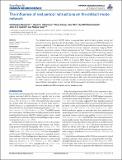| dc.contributor.author | Raschle, Nora M. | |
| dc.contributor.author | Lee, Michelle Ann | |
| dc.contributor.author | Buechler, Roman | |
| dc.contributor.author | Christodoulou, Joanna A | |
| dc.contributor.author | Chang, Maria | |
| dc.contributor.author | Vakil, Monica | |
| dc.contributor.author | Stering, Patrice L. | |
| dc.contributor.author | Gaab, Nadine | |
| dc.date.accessioned | 2017-01-25T18:03:25Z | |
| dc.date.issued | 2009 | |
| dc.identifier.citation | Raschle, Nora M., Michelle Lee, Roman Buechler, Joanna A. Christodoulou, Maria Chang, Monica Vakil, Patrice L. Stering, and Nadine Gaab. 2009. “Making MR Imaging Child’s Play - Pediatric Neuroimaging Protocol, Guidelines and Procedure.” JoVE (29) (July 30). doi:10.3791/1309. | en_US |
| dc.identifier.issn | 1940-087X | en_US |
| dc.identifier.uri | http://nrs.harvard.edu/urn-3:HUL.InstRepos:30085091 | |
| dc.description.abstract | Within the last decade there has been an increase in the use of structural and functional magnetic resonance imaging (fMRI) to investigate the neural basis of human perception, cognition and behavior 1, 2. Moreover, this non-invasive imaging method has grown into a tool for clinicians and researchers to explore typical and atypical brain development. Although advances in neuroimaging tools and techniques are apparent, (f)MRI in young pediatric populations remains relatively infrequent 2. Practical as well as technical challenges when imaging children present clinicians and research teams with a unique set of problems 3, 2. To name just a few, the child participants are challenged by a need for motivation, alertness and cooperation. Anxiety may be an additional factor to be addressed. Researchers or clinicians need to consider time constraints, movement restriction, scanner background noise and unfamiliarity with the MR scanner environment2,4-10. A progressive use of functional and structural neuroimaging in younger age groups, however, could further add to our understanding of brain development. As an example, several research groups are currently working towards early detection of developmental disorders, potentially even before children present associated behavioral characteristics e.g.11. Various strategies and techniques have been reported as a means to ensure comfort and cooperation of young children during neuroimaging sessions. Play therapy 12, behavioral approaches 13, 14,15, 16-18 and simulation 19, the use of mock scanner areas 20,21, basic relaxation 22 and a combination of these techniques 23 have all been shown to improve the participant's compliance and thus MRI data quality. Even more importantly, these strategies have proven to increase the comfort of families and children involved 12. One of the main advances of such techniques for the clinical practice is the possibility of avoiding sedation or general anesthesia (GA) as a way to manage children's compliance during MR imaging sessions 19,20. In the current video report, we present a pediatric neuroimaging protocol with guidelines and procedures that have proven to be successful to date in young children. | en_US |
| dc.language.iso | en_US | en_US |
| dc.publisher | MyJove Corporation | en_US |
| dc.relation.isversionof | doi:10.3791/1309 | en_US |
| dash.license | LAA | |
| dc.title | Making MR Imaging Child's Play - Pediatric Neuroimaging Protocol, Guidelines and Procedure | en_US |
| dc.type | Journal Article | en_US |
| dc.description.version | Version of Record | en_US |
| dc.relation.journal | Journal of Visualized Experiments | en_US |
| dash.depositing.author | Gaab, Nadine | |
| dc.date.available | 2017-01-25T18:03:25Z | |
| dc.identifier.doi | 10.3791/1309 | * |
| dash.contributor.affiliated | Lee, Michelle Ann | |
| dash.contributor.affiliated | Christodoulou, Joanna | |
| dash.contributor.affiliated | Gaab, Nadine | |
| dc.identifier.orcid | 0000-0001-8167-8021 | |


